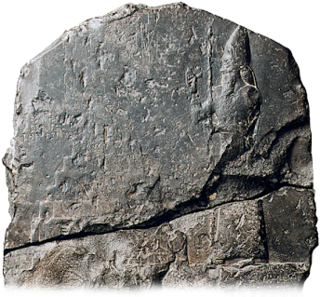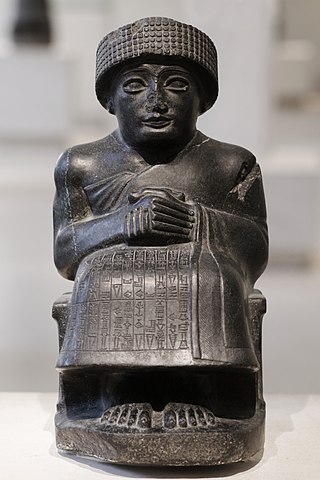
Nebuchadnezzar II, also spelled Nebuchadrezzar II, was the second king of the Neo-Babylonian Empire, ruling from the death of his father Nabopolassar in 605 BC to his own death in 562 BC. Historically known as Nebuchadnezzar the Great, he is typically regarded as the empire's greatest king. Nebuchadnezzar remains famous for his military campaigns in the Levant, for his construction projects in his capital, Babylon, including the Hanging Gardens of Babylon, and for the role he plays in Jewish history. Ruling for 43 years, Nebuchadnezzar was the longest-reigning king of the Babylonian dynasty. By the time of his death, he was among the most powerful rulers in the world.
Etemenanki was a ziggurat dedicated to the Mesopotamian god Marduk in the ancient city of Babylon. It now exists only in ruins, located about 90 kilometres (56 mi) south of Baghdad, Iraq. Many scholars have identified Etemenanki as a likely inspiration for the biblical story of the Tower of Babel.

The Hanging Gardens of Babylon were one of the Seven Wonders of the Ancient World listed by Hellenic culture. They were described as a remarkable feat of engineering with an ascending series of tiered gardens containing a wide variety of trees, shrubs, and vines, resembling a large green mountain constructed of mud bricks. It was said to have been built in the ancient city of Babylon, near present-day Hillah, Babil province, in Iraq. The Hanging Gardens' name is derived from the Greek word κρεμαστός, which has a broader meaning than the modern English word "hanging" and refers to trees being planted on a raised structure such as a terrace.

The Pergamon Museum is a listed building on the Museum Island in the historic centre of Berlin, Germany. It was built from 1910 to 1930 by order of Emperor Wilhelm II and according to plans by Alfred Messel and Ludwig Hoffmann in Stripped Classicism style. As part of the Museum Island complex, the Pergamon Museum was added to the UNESCO World Heritage List in 1999 because of its architecture and testimony to the evolution of museums as architectural and social phenomena.

Ancient art refers to the many types of art produced by the advanced cultures of ancient societies with different forms of writing, such as those of ancient China, India, Mesopotamia, Persia, Palestine, Egypt, Greece, and Rome. The art of pre-literate societies is normally referred to as prehistoric art and is not covered here. Although some pre-Columbian cultures developed writing during the centuries before the arrival of Europeans, on grounds of dating these are covered at pre-Columbian art and articles such as Maya art, Aztec art, and Olmec art.

The Ishtar Gate was the eighth gate to the inner city of Babylon. It was constructed c. 569 BC by order of King Nebuchadnezzar II on the north side of the city. It was part of a grand walled processional way leading into the city.
Borsippa or Birs Nimrud is an archeological site in Babil Governorate, Iraq. The ziggurat is today one of the most vividly identifiable surviving ones, identified in the later Arabic culture with the Tower of Babel due to Nebuchadnezzar referring to it as the Tower of Borsippa or tongue tower, as stated in the stele recovered on site in the 19th century. However, modern scholarship concludes that the Babylonian builders of the Ziggurat in reality erected it as a religious edifice in honour of the local god Nabu, called the "son" of Babylon's Marduk, as would be appropriate for Babylon's lesser sister-city.

Robert Johann Koldewey was a German archaeologist, famous for his in-depth excavation of the ancient city of Babylon in modern-day Iraq. He was born in Blankenburg am Harz in Germany, the duchy of Brunswick, and died in Berlin at the age of 69.

The Burney Relief is a Mesopotamian terracotta plaque in high relief of the Isin-Larsa period or Old-Babylonian period, depicting a winged, nude, goddess-like figure with bird's talons, flanked by owls, and perched upon two lions.
Aššur-rēša-iši I, inscribed maš-šur-SAG-i-ši and meaning “Aššur has lifted my head,” ruled 1132–1115 BC, son of Mutakkil-Nusku, was a king of Assyria, the 86th to appear on the Assyrian King List and ruled for 18 years. The Synchronistic King List and its fragmentary copies give him as a contemporary of the Babylonian kings Ninurta-nādin-šumi, Nebuchadnezzar I and Enlil-nādin-apli, although the last of these is unlikely per the commonly accepted chronology.

The Istanbul Archaeology Museums are a group of three archaeological museums located in the Eminönü quarter of Istanbul, Turkey, near Gülhane Park and Topkapı Palace. These museums house over one million objects from nearly all periods and civilizations in world history.

The Neo-Babylonian Empire or Second Babylonian Empire, historically known as the Chaldean Empire, was the last polity ruled by monarchs native to Mesopotamia until Faisal II in the 20th century. Beginning with the coronation of Nabopolassar as the King of Babylon in 626 BC and being firmly established through the fall of the Assyrian Empire in 612 BC, the Neo-Babylonian Empire was conquered by the Achaemenid Persian Empire in 539 BC, marking the collapse of the Chaldean dynasty less than a century after its founding.

The Chaldean dynasty, also known as the Neo-Babylonian dynasty and enumerated as Dynasty X of Babylon, was the ruling dynasty of the Neo-Babylonian Empire, ruling as kings of Babylon from the ascent of Nabopolassar in 626 BC to the fall of Babylon in 539 BC. The dynasty, as connected to Nabopolassar through descent, was deposed in 560 BC by the Aramean official Neriglissar, though he was connected to the Chaldean kings through marriage and his son and successor, Labashi-Marduk, might have reintroduced the bloodline to the throne. The final Neo-Babylonian king, Nabonidus, was genealogically unconnected to the previous kings, but might, like Neriglissar, also have been connected to the dynasty through marriage.

The Department of the Middle East, numbering some 330,000 works, forms a significant part of the collections of the British Museum, and the world's largest collection of Mesopotamian antiquities outside Iraq. The collections represent the civilisations of the ancient Near East and its adjacent areas.

Babylon was an ancient city located on the lower Euphrates river in southern Mesopotamia, within modern-day Hillah, Iraq, about 85 kilometers south of modern day Baghdad. Babylon functioned as the main cultural and political centre of the Akkadian-speaking region of Babylonia. Its rulers established two important empires in antiquity, the 19th–16th century BC Old Babylonian Empire, and the 7th–6th century BC Neo-Babylonian Empire. Babylon was also used as a regional capital of other empires, such as the Achaemenid Empire. Babylon was one of the most important urban centres of the ancient Near East, until its decline during the Hellenistic period. Nearby ancient sites are Kish, Borsippa, Dilbat, and Kutha.

Jehoiachin's rations tablets date from the 6th century BC and describe the oil rations set aside for a royal captive identified with Jeconiah, king of Judah. Tablets from the royal archives of Nebuchadnezzar II, emperor of the Neo-Babylonian Empire, were unearthed in the ruins of Babylon that contain food rations paid to captives and craftsmen who lived in and around the city. On one of the tablets, "Ya’u-kīnu, king of the land of Yahudu" is mentioned along with his five sons listed as royal princes.
The Deutsche Orient-Gesellschaft, abbreviated DOG, is a German voluntary association based in Berlin dedicated to the study of the Near East.

The art of Mesopotamia has survived in the record from early hunter-gatherer societies on to the Bronze Age cultures of the Sumerian, Akkadian, Babylonian and Assyrian empires. These empires were later replaced in the Iron Age by the Neo-Assyrian and Neo-Babylonian empires. Widely considered to be the cradle of civilization, Mesopotamia brought significant cultural developments, including the oldest examples of writing.

The Panel with striding lion is a panel of Neo-Babylonian glazed ceramic bricks or tiles dated to 604–562 B.C., now in the Metropolitan Museum of Art, New York. It was one of many that lined the Processional Way north of the Ishtar Gate. It was excavated by R. Koldewey in 1902, and at the Staatliche Museen zu Berlin from 1926, before coming into the possession of the Met in 1931.

The Palace of Darius in Susa was a palace complex that was built at the site of Susa, Iran, during the reign of Darius I over the Achaemenid Empire. The construction was conducted parallel to that of Persepolis. Manpower and raw materials from various parts of the Achaemenid Empire contributed to its construction. It was once destroyed by fire and was partially restored later; little has remained from the complex, which is today part of an archaeological site.

















